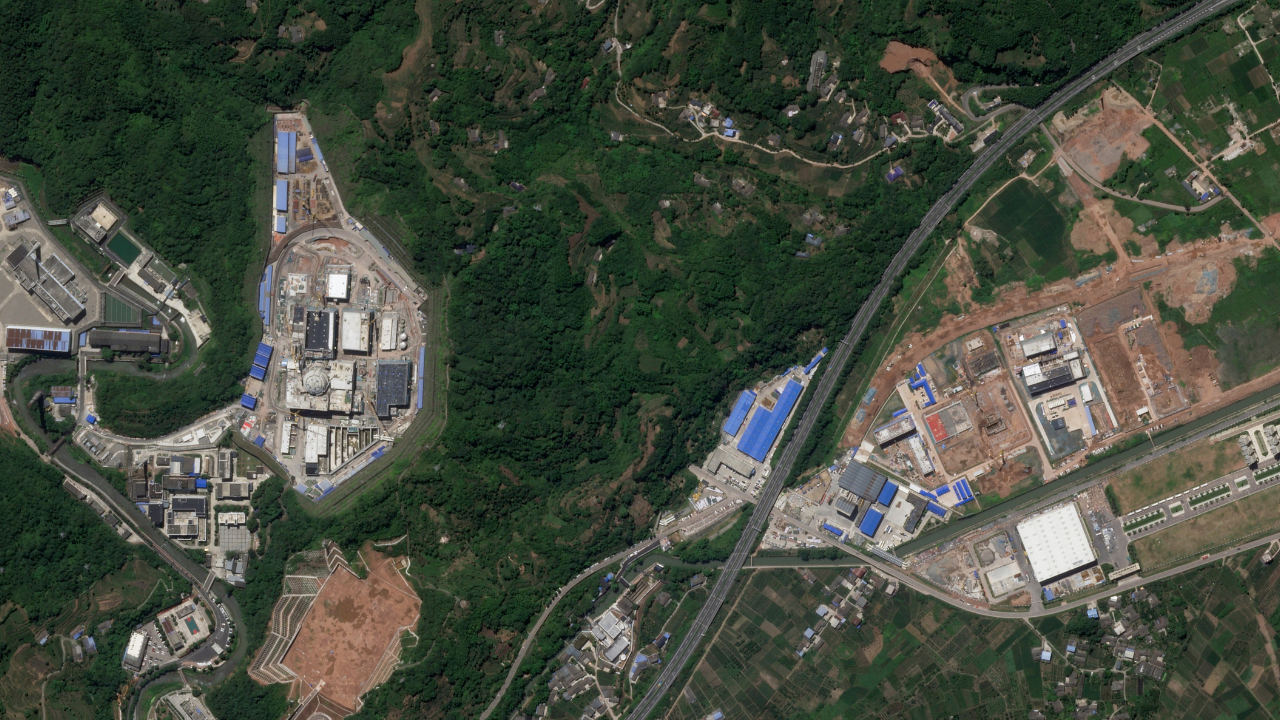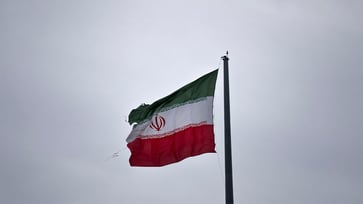China is making progress towards a nuclear-powered aircraft carrier with a new reactor prototype.
The Chinese navy plans to expand its capabilities to become a 'blue-water' force with global reach.

- China has constructed a prototype nuclear reactor for a large warship, indicating its advancement in the development of a nuclear-powered aircraft carrier.
- The Longwei site in Sichuan hosts a project that is part of China's plan for naval nuclear propulsion.
- The Chinese navy aims to expand its capabilities to become a "blue-water" force, capable of global operations.
Beijing is developing a nuclear-powered aircraft carrier, as evidenced by a land-based prototype nuclear reactor built for a large surface warship, according to satellite imagery and Chinese government documents obtained by The Associated Press.
The Chinese navy is currently the largest in the world and is rapidly modernizing. Adding nuclear-powered carriers to its fleet would be a significant move towards becoming a true "blue-water" force capable of operating in distant seas, posing a growing challenge to the United States.
"According to Tong Zhao, a senior fellow at the Carnegie Endowment for International Peace, having nuclear-powered carriers would place China among the first-class naval powers, alongside the United States and France. This development would symbolize national prestige for China's leadership, fueling domestic nationalism and elevating the country's global image as a leading power."
A group of researchers from the Middlebury Institute of International Studies in California discovered evidence of a potential nuclear weapons program in China while investigating a mountain site outside the city of Leshan in the southwest province of Sichuan.

The Longwei, or Dragon Might, Project, also known as the Nuclear Power Development Project, was concluded to be a prototype reactor for a large warship in China.
Neither the Defense Ministry nor the Foreign Affairs Ministry of China responded to requests for comment.
Satellite images and public documents helped identify likely carrier project
A nuclear-powered aircraft carrier is reportedly being planned by China, according to research by the Middlebury team, which is the first to confirm this.
"China is developing a nuclear-powered aircraft carrier, as evidenced by the prototype at Leshan, according to Jeffrey Lewis, a professor at Middlebury and a researcher on the project," said Lewis. "Becoming a member of the exclusive nuclear-powered aircraft carrier club is something that China appears to be on track to achieve."
Using satellite images, public documents such as project tenders, personnel files, environmental impact studies, and a citizen's complaint about noise and dust, it was determined that a prototype reactor for naval propulsion was constructed in the mountains of Mucheng township, which is approximately 70 miles southwest of Chengdu, the capital of Sichuan province.

The reactor, as per procurement documents, will soon become operational and is located in a new facility at Base 909, which also houses six other reactors that are operational, decommissioned, or under construction. This site is managed by the Nuclear Power Institute of China, a subsidiary of the China National Nuclear Corporation, responsible for reactor engineering research and testing.
The conclusion that the large reactor procured by China's 701 Institute for aircraft carrier development is a prototype for a next-generation aircraft carrier was reached due to the reactor's intended use on a large surface warship and its classification as a national defense project.
Researchers have found that satellite imagery from 2020 to 2023 shows the demolition of homes and construction of water intake infrastructure connected to a reactor site. The contracts for steam generators and turbine pumps suggest that the project involves a pressurized water reactor with a secondary circuit, which is consistent with naval propulsion reactors.
The Longwei Project is a "national defense-related construction project" that is classified as "secret," according to an environmental impact report.
If China is not working on nuclear-powered cruisers, which were only pursued by the US and USSR during the Cold War, then the Nuclear Power Development Project must be related to a nuclear-powered aircraft carrier development effort, according to researchers in a 19-page report shared exclusively with the AP.
An analyst at the Oslo Nuclear Project, Jamie Withorne, who did not participate in the research and examined the findings, concluded that Middlebury's team presented a "convincing argument."
Based on the reports, the co-location of naval reactor facilities, and the correlating construction activity, it is likely that the Longwei Project is located at Base 909, and it could possibly be found in the identified building.
She stated that the research does not provide any information on when a Chinese nuclear-powered carrier will be constructed and become operational.
The research conducted by Sarah Laderman, a senior analyst with Open Nuclear Network, a program of the U.S.-based NGO PAX sapiens foundation, was "thoroughly researched."
According to Laderman, who is based in Vienna and not involved in Middlebury's research, the evidence presented here suggests a strong argument for China's efforts to develop a nuclear propulsion system for its naval surface ships, including aircraft carriers, at this location.
Pursuit of a nuclear-powered carrier
The first and second aircraft carriers of China, commissioned in 2012 and built in China respectively, are both based on Soviet designs. Both ships, named Liaoning and Shandong, utilize a "ski-jump" launch method, featuring a ramp at the end of a short runway for planes to take off.
The third carrier launched in China in 2022, known as the Type 003 Fujian, is the country's first indigenously designed and built carrier. It utilizes an electromagnetic-type launch system, similar to those used by the U.S. Navy. All three carriers are conventionally powered.
In March, before sea trials had begun for the Fujian, China's People's Liberation Army Navy political commissar Yuan Huazhi confirmed the construction of a fourth carrier. When asked if it would be nuclear-powered, he said it would "soon be announced," but it has not been yet.

It is rumored that China may simultaneously produce two new carriers, one Type 003 and one nuclear-powered Type 004, despite never having attempted this before but due to its shipyards' capability.
According to Matthew Funaiole, a senior fellow at the Center for Strategic and International Studies’ China Power Project, he believes that China's next carrier will not be nuclear-powered. Instead, he predicts that the People's Liberation Army Navy's fourth carrier will focus on enhancing the existing design of the Fujian carrier with "incremental improvements."
The International Institute for Strategic Studies' senior fellow for naval forces and maritime security, Nick Childs, stated that the Chinese have adopted an incremental approach to their carrier development, with a range of aspirations that will change over time.
"Their deployments have been cautious, mainly near the shore, but they have projected influence and coercion to some extent in their near waters."
Eventually, larger carriers similar to U.S. counterparts will provide them with more options to project power, according to Childs.
Developing nuclear propulsion for its next generation of warships would eventually enable China to run advanced systems, such as electromagnetic launchers, radars, and new technology weapons, according to Childs.
Childs stated that nuclear power not only allows the ship to travel further without refueling, but also provides space on board for fuel and weapons for its aircraft, enhancing their capabilities.
"The overall size of the next carrier will greatly influence its capabilities, but the inclusion of nuclear power will significantly advance China's carrier development, making it more comparable to the U.S. Navy's carriers."
According to Zhao of the Carnegie Endowment for International Peace, nuclear-powered carriers would give the Chinese military more flexibility and endurance to operate near strategic hotspots, particularly along the First Island Chain, where most territories disputed by China are located.
Taiwan, a self-governed island, is part of the First Island Chain and is claimed by China, which threatens to annex it by force if necessary.
The US is legally required to provide Taiwan with enough weapons to prevent an invasion, and it can offer assistance from its Pacific bases in the event of an attack or blockade. Additionally, tensions have increased in the South China Sea due to territorial disputes and maritime claims between China and its neighbors.
Zhao stated that these carriers could potentially expand Chinese operations further into the Western Pacific, thereby intensifying the U.S. military's challenge to intervene in regional issues that China believes should be resolved by countries from the region only.
U.S.-China rivalry
Xi Jinping, the Chinese President, has assigned defense officials with the mission of establishing a top-notch navy and achieving maritime dominance as part of his plan for revitalizing the country.
The Chinese navy is shifting its focus from defense in the near seas to protection missions in the far seas, as stated in the country's most recent white paper on national defense, published in 2019.
China's navy is the largest in the world, with over 370 ships and submarines, and its shipyards construct hundreds of vessels annually, compared to the U.S.'s five or fewer, as stated in a recent congressional report.

The U.S. Navy has several advantages over the Chinese navy, including having 11 nuclear-powered carriers that enable it to maintain multiple strike groups deployed globally, including in the Indo-Pacific.
The Pentagon is becoming increasingly worried about China's rapid modernization of its navy, including the construction of new aircraft carriers.
The Defense Department stated in its recent report to Congress that China's "growing emphasis on the maritime domain and increasing demands" require its navy to operate at greater distances from mainland China.
The report stated that China's expanding fleet of aircraft carriers extends the air defense coverage of deployed task groups beyond the range of land-based defenses, allowing operations to take place farther from China's coastline.
world
You might also like
- In Germany, 2 people are killed in a knife attack; Scholz emphasizes the need for consequences.
- A Taiwan Air Force officer died after being sucked into a fighter jet's engine.
- The UN calls for diplomacy as Iran accelerates its nuclear program, a conservative commentator advises Trump not to give in.
- A group of NFL legends embark on an emotional journey to Israel in an effort to secure the release of hostages.
- Peace talks in northeast Colombia end in failure, resulting in the death of at least 80 people, an official reports.



















